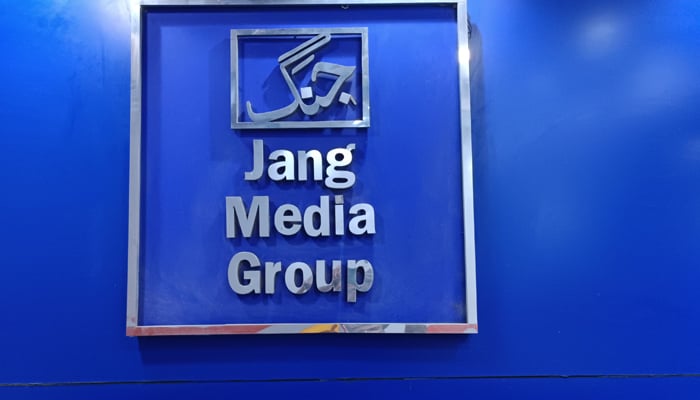Jang group’s role in women emancipation and their portrayal in media
As women, we firmly believe in the transformative potential of media
In the 18th century, the emergence of women as suffrage leaders and rights activists gained prominence in Europe and America. During this period, women felt acutely aware of their exclusion from mainstream news coverage, hindering the dissemination of their ideas and demands for equality with men. The prevailing narrative often depicted them in the media as curiosities and an aggressive element of society. However, this portrayal served as inspiration for many women worldwide to confront biases against them.
This movement culminated in the U.N. Decade for Women (1976-1985), during which leaders advocated for an increased global flow of news from progressive women’s perspectives. This highlighted the significance of women gaining representation in the media. Despite the efforts made by women leaders to enhance this representation, the portrayal of women in the media remains a core issue even in the 21st century. The struggle for accurate and empowering representation continues, reflecting the ongoing challenges faced by women in achieving equitable visibility in the media landscape.
The issue of non-portal of women in the media has garnered attention from various research studies as well, including those by Woodrow Wilson (2009), Syed Hassan Raza & Muhammad Zeshan Haider (2016), and Anjum Zia (2007). These studies have delved into the traditional and non-traditional portrayals of women in mainstream media, exploring topics such as “Media and Gender: A Pakistan Perspective.” The consensus among these analyses is unfortunate; media tends to perpetuate gender inequality by reinforcing stereotypical gender portrayals and traditional perceptions of gender roles.
As the fourth pillar, print and electronic media play a crucial role in the emancipation of women in Pakistan. While the number of women in the country is on the rise, so are the issues they face. Unfortunately, their representation and portrayal in the media often do not correspond to the challenges they endure. In the early decades following Pakistan’s independence, women were frequently objectified to serve commercial interests in society. During the 1960s, 70s, and 80s in Pakistan, women were predominantly confined to traditional roles, primarily centered around household chores such as cooking, cleaning, and child-rearing. During this period, women often found themselves without a voice, unable to articulate their concerns.
In contrast, a closer examination of the Jang Group reveals a noteworthy effort, particularly by the leading newspaper, to carve out a distinctive space for women in the media. This involves granting them significant representation, especially in the context of how society treats them. This is particularly significant because, in many cases, women may not be fully aware of the biased attitudes prevailing in society and the media towards them.
Geo, as part of the Jang Group, has taken steps to mitigate the stereotypical portrayal of women in its dramas and other social programs by creating more balanced content. Recognizing the importance of altering these narratives, both Jang Group and Geo contribute to challenging societal biases and fostering a more equitable representation of women in the media.
Responsible gender reporting is a crucial matter, and the Jang Group has been a leading channel in exemplifying the responsibility of reporting concerning women and the portrayal of women in electronic media. This commitment to responsible reporting has gradually influenced private TV channels to follow suit.
In addressing gender-based issues and advocating against abuse, Geo has played a significant role by shedding light on numerous gender-sensitive stories. For instance, the coverage of the tragic incidents involving Zainab, a victim of rape and murder, and Rizwana, a 14-year-old domestic helper subjected to severe domestic violence, exemplifies Geo’s dedication to raising awareness on such matters. The consistent reporting on these incidents by Geo for several days reflects a commitment to ensuring that these issues are not overlooked.
Geo and Jang have also been instrumental in bringing attention to various cases involving women, such as those related to rape, harassment, and discrimination. By highlighting these issues, both media outlets contribute to fostering gender sensitisation in society and creating awareness about the challenges women face.
Reporting and writing about women in the media, as well as their portrayal, cannot be divorced from the current struggles they face in society. This integration must be institutionalized through media representation. The Jang Group has actively assumed a conscious leadership role in reflecting the responsibility of reporting on women, a stance that is slowly being adopted by private TV channels. Reporting with a sense of responsibility emerges as a pivotal aspect in this endeavor.
The media serves as a powerful instrument for social change, yet there have been instances of inaccurate representation of women, often overlooking their significant socio-economic roles in society. The portrayals are frequently stereotypical, depicting women with weak and feeble personalities. However, there has been an innovative effort to reshape the representation of women through content, particularly exemplified by a popular section in Akhbar-i-Jahan, an Urdu weekly magazine printed under the umbrella of Jang Group, titled “Teen Aurtein Teen Kahaniyan” (Three Women, Three Stories).
This concept was unique, especially during a time when social media did not exist, and mainstream media was not extensively reporting or addressing women’s issues, especially their domestic stories. This groundbreaking initiative was spearheaded by the magazine, introducing three distinct stories from three different women. It was a noteworthy departure from the norm, as it catered to both female and male readers, offering relatable narratives.
Saeeda Afzal who actually started this section, in a recent interview to a Web channel, while describing the method of collecting these stories, narrated, “We used to derive the content for this section from stories narrated by rural women. Additionally, women from different cities used to share stories with us through letters or through face-to-face meetings. We would visit Dar-ul-Amaan to meet women and take their stories. After listening to all details carefully, we would print these stories with complete responsibly.”
The stories presented in “Teen Aurtein Teen Kahaniyan” were designed to captivate audiences of all ages, providing a platform for women to identify with and connect to these narratives. This magazine played a pioneering role by initiating a trend in addressing women’s issues, particularly those related to domestic and societal life, at a time when such discussions were not commonplace in the media. The unique feature of this publication enabled it to capture a broad segment of society, shedding light on gender roles and serving as a moral lesson for women.
This was a period, when women often found themselves without a voice, unable to articulate their concerns. Addressing this void and providing a platform for women to narrate their issues, especially those that resonated with others, became a crucial initiative within this magazine segment. Unlike stories crafted and recounted by historians, these narratives were articulated from women’s perspectives, showcasing the potent identification with other women’s stories. The women involved were portrayed as legitimate storytellers, a recognition that might not have been afforded to them by society otherwise. One such story bore the title “Such Azab They,” emphasising the role of these women as oral historians.
During that period, women were not represented in the media as they are today. The stories vividly depicted the unconscious biases faced by women from their families and society. The narratives highlighted how the hard work of women was undermined, devalued, and robbed of recognition, subtly challenging cultural beliefs.
It’s conceivable that this approach posed a significant challenge to the prevailing masculine writing of the time. By breaking the chain of silence, these stories not only recorded the memories of the women themselves but also those of the people around them, providing a richer reflection. Today, generations later, these stories continue to resonate, as the memories are passed down through our mothers and grandmothers. This enduring power of women’s stories is evident in the way they remember and preserve these narratives in their own memories over several decades.
As women, we firmly believe in the transformative potential of media. It can play a pivotal role in amplifying women’s voices in society by incorporating gender-transformative content in both print and electronic media. Breaking free from gender stereotypes and advocating for a more inclusive focus in the future is essential for fostering positive change and challenging existing norms.
The author is a political Economist and a prestigious award winner of Martin Luther King Award, United State
-
 Jason Momoa Cherishes Hosting Ozzy Osbourne's Final Gig Ahead Of His Death
Jason Momoa Cherishes Hosting Ozzy Osbourne's Final Gig Ahead Of His Death -
 Real Reason Timothee Chalamet Thanked Kylie Jenner At Awards Revealed
Real Reason Timothee Chalamet Thanked Kylie Jenner At Awards Revealed -
 Will King Charles Attend Funeral Of Prince Philip's First Cousin, Princess Irene?
Will King Charles Attend Funeral Of Prince Philip's First Cousin, Princess Irene? -
 'Furious' Prince William Wants Andrew As Far Away As Possible
'Furious' Prince William Wants Andrew As Far Away As Possible -
 Blood Moon: When And Where To Watch In 2026
Blood Moon: When And Where To Watch In 2026 -
 Apple Foldable IPhone Tipped For 2026 Launch With A20 Pro Chip And C2 Modem
Apple Foldable IPhone Tipped For 2026 Launch With A20 Pro Chip And C2 Modem -
 Meghan Lends Credence To Reports Of Rift With Kim Kardashian On Chicago's Birthday
Meghan Lends Credence To Reports Of Rift With Kim Kardashian On Chicago's Birthday -
 Florida Woman’s Alleged Bid To Bribe Police Ends In Unexpected Discovery
Florida Woman’s Alleged Bid To Bribe Police Ends In Unexpected Discovery -
 James Van Der Beek Strongly Opposes The Idea Of New Year In Winter
James Van Der Beek Strongly Opposes The Idea Of New Year In Winter -
 Elon Musk’s Starlink Rival Eutelsat Partners With MaiaSpace For Satellite Launches
Elon Musk’s Starlink Rival Eutelsat Partners With MaiaSpace For Satellite Launches -
 Fans Feel For Leonardo DiCaprio As He Gets Awkwardly Snubbed: Watch
Fans Feel For Leonardo DiCaprio As He Gets Awkwardly Snubbed: Watch -
 Japan Launches The World’s First Trial To Extract Rare Earth Elements
Japan Launches The World’s First Trial To Extract Rare Earth Elements -
 Prince Harry Breaks Cover In California Amid Tension At Home With Meghan Markle
Prince Harry Breaks Cover In California Amid Tension At Home With Meghan Markle -
 ASAP Rocky Makes Massive Comeback With New Album
ASAP Rocky Makes Massive Comeback With New Album -
 Amanda Seyfried Unveils How Channing Tatum Teased Her On 'Dear John' Set
Amanda Seyfried Unveils How Channing Tatum Teased Her On 'Dear John' Set -
 Blue Moon 2026: Everything You Need To Know
Blue Moon 2026: Everything You Need To Know




